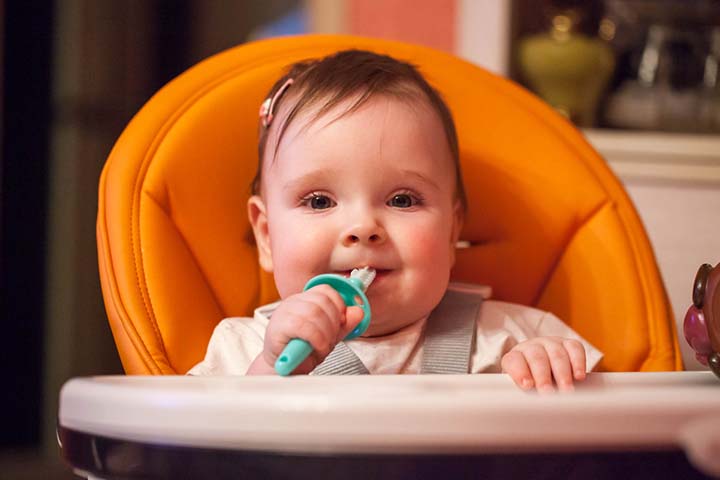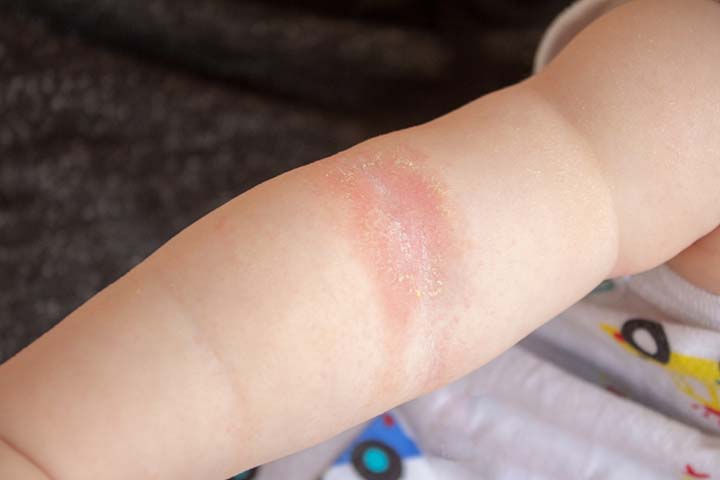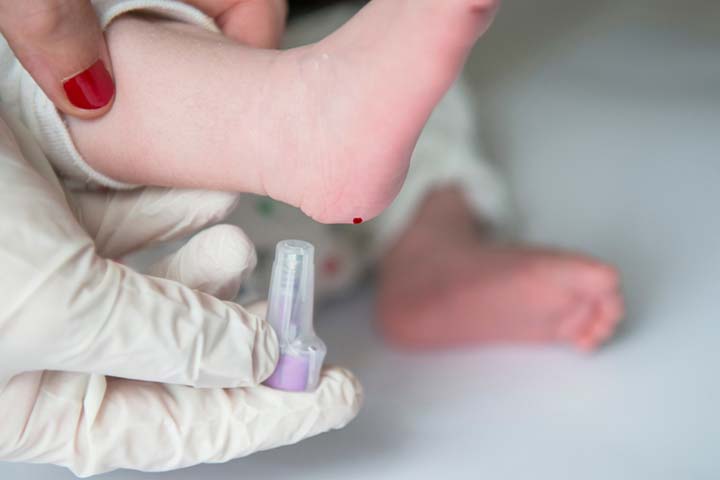Infectious mononucleosis (mono), also known as glandular fever or kissing disease, is a viral illness that causes flu-like symptoms, tiredness, and enlargement of the lymph glands. Mono occurs globally in any season.
Although it is common among adolescents and young adults, newborns may contract viruses through the oral secretions of parents, siblings, or anyone who is infected and in close contact with them (1).
Read this MomJunction post to know about the causes, signs, symptoms, diagnosis, treatment, and prevention of mononucleosis in babies.
Causes Of Mononucleosis In Babies
Epstein-Barr virus (EBV) or human gammaherpesvirus is the primary cause of infectious mononucleosis. According to a National Institutes of Health study, the Epstein-Barr virus (EBV) is highly prevalent, infecting more than 90% of individuals worldwide. Other viruses, such as cytomegalovirus, can also cause mononucleosis, but the clinical presentation may vary from EBV infection.
The incubation period of mono can be around six weeks. During this time, the virus replicates in the oral cavity and enters the blood. The exact time of virus transmission is not known (2)
The disease usually spreads from the saliva of infected people. Babies may contract the infection in any of the following ways (1):
- Kissing
- Exposure to sneeze or cough
- Sharing spoons or glasses
- Chewing used toothbrushes
- Pre-chewing foods (premastication or kiss feeding, which means chewing food in order to feed that to the baby)
- Straws
It is a contagious disease, and the virus may remain inactive in babies’ throat and blood cells for a long time after the acute illness.
Signs And Symptoms Of Mononucleosis In Babies
Some babies may not develop any symptoms or may have only mild symptoms of mono. The following symptoms are usually seen in a few babies (3) (4):
- Fever
- Fatigue
- Sore throat
- Skin rash
- Difficulty in swallowing
- Swollen lymph glands, often in the neck, underarms, and groin
- Body ache
- Swollen liver
- Jaundice (rare)
- Spleen swelling
Although rare, you may also notice the following signs and symptoms:
- Decreased appetite
- Swollen eyelids
- PhotosensitivityiXA condition that causes hypersensitivity to sunlight, leading to excessive sunburn or rash upon exposure
- AnemiaiXA condition where the body lacks red blood cells for sufficient oxygen supply throughout the body
The signs and symptoms may disappear in four weeks; however, in some cases, babies may have extreme fatigue for a few more weeks. These symptoms can also be seen in other diseases and, therefore, you may seek medical care for an exact diagnosis.
The virus can remain inactive in the oral cavity and blood cells for a lifetime after the infection. Usually, there is no risk for developing mononucleosis again after the primary infection.
Symptoms may come on gradually about 4-6 weeks after someone is infected with the virus. When symptoms appear, they may be severe for a few days before slowly getting milder. If symptoms linger or get worse, call your doctor.
Complications Of Mono In Babies
The course of mononucleosis is comparatively mild in babies. However, there is a risk of developing complications, such as (1) (5):
- Upper airway obstruction from swollen tonsils
- Meningitis—inflammation of the membrane covering the brain and spinal cord. Fever, stiff neck, and bulging of the head are often noticed in babies during meningitis.
- Encephalitis—inflammation of the brain. You may notice sleepiness, skin rash, stiff neck, etc. during encephalitis. Babies may also have seizures during brain inflammation.
- Guillain-Baree syndrome—a rare complication in which the immune system attacks the nerves. It may occur later in the course of the disease and is often associated with neurological symptoms (6). It may even cause respiratory distress in some people.
- Myocarditis—an inflammation of the heart muscles often associated with high viral load.
- Thrombocytopenia a rare form of EBV infection associated with a slight decrease in platelet count.
- Orchitis—an inflammation of the testes.
- Rupture of the spleen
- Hepatitis- Some reports suggest that EBV infection may cause mild hepatocellular hepatitis (7).
- Pneumonia- In a patient with a history of infectious mononucleosis, a study revealed an incidence of pneumonitis induced by EBV (8).
- Leukopenia- in a few rare cases, EBV has been associated with leukopenia, characterized by lower-than-normal white blood cells (9).
Diagnosis Of Mononucleosis In Babies
Your doctor may diagnose mononucleosis from symptoms and examination of the lymph glands. The following tests may be done to confirm the diagnosis (10):
- Blood tests: White blood cell count and the presence of atypical lymphocytes are crucial to the diagnosis of mono.
- Monospot test or heterophile antibody test: This test helps identify the antibodies produced as a result of an EBV infection. Antibody analysis helps differentiate the cause of mononucleosis. Viruses other than EBV give negative results during heterophile antibody tests.
Your doctor may also order some additional tests to diagnose mononucleosis. Complications often require ECG or EEG tests, or cerebrospinal fluid analysis.
Treatment Of Mononucleosis In Babies
Mononucleosis is a self-limiting disease in healthy babies, and the symptoms are relieved within two to eight weeks. There is no particular therapy or vaccine to treat or prevent mononucleosis. The following ways may help your baby in recovery (11) (12):
- Giving enough fluids or breastmilk
- Taking enough rest to recover
- Administering acetaminophen for fever and pain
- Administering corticosteroidsiXA group of steroid hormones produced in the adrenal cortex that are used for treatments in synthetic form to reduce inflammation to reduce throat pain and swelling if the swollen tonsils cause breathing problems
Do not give over-the-counter medications to babies without a doctor’s advice. Your baby may require hospitalization in severe cases. Mono can be critical in babies with low immunity, and they may require supportive treatments and antiviral treatments. Your doctor may prescribe medications based on the severity of symptoms and complications of mono.
Note: Antibiotic treatments are not given since mono is a viral infection. Inappropriate use of antibiotics could lead to resistance.
Prevention Of Mono In Babies
There is no approved vaccine or medication to prevent mononucleosis. The following tips may help prevent mono in babies (13):
- Do not share the baby’s utensils with other family members
- Grind or crush solid food for babies instead of pre-chewing
- Keep used toothbrushes or teethers out of babies’ reach
1. Can a parent get mono from a child?
Yes, a parent may get the infection from a child (17).
2. When is mono most contagious?
Mono is most contagious from just before the onset of symptoms until they go away. However, infected people may remain infectious for months after their symptoms subside (18).
3. Can a baby get mononucleosis more than once?
Most people develop mononucleosis only once in their lifetime despite having the inactive virus in their body after the symptoms fade. However, in extremely rare cases of a weakened immune system, people may develop mono symptoms again (19)
4. What is the typical age range for babies to get mononucleosis?
Mononucleosis is a common infection that can occur at any age, but it is more common between 15 and 30 years of an individual’s life (20).
Although mononucleosis in babies is not congenital and common, they may develop the disease from an infected adult through kissing, sharing utensils, or exposure to cough. If your baby has mononucleosis, they may show symptoms such as fever, fatigue, swollen liver and spleen, and jaundice. Since mononucleosis is a self-limiting disease, these symptoms may disappear after a few weeks; however, the virus may stay active in the oral cavity for a lifetime. To treat the condition in babies, give them fluids or breast milk and provide rest. Always consult a doctor for the medicines to be administered to the babies. In rare cases, infections with EBV may increase the risk of nasopharyngeal canceriXA rare form of cancer that develops in the upper portion of the throat, behind the nose causing difficulty breathing and swallowing, Hodgkin’s lymphomaiXCancer that affects the lymphatic system, leading to symptoms such as enlarged lymph nodes and reduced immunity, and Burkitt’s lymphomaiXCancer more common in children than adults, affecting the lymphatic system and characterized by stomach pain, weakness, and fatigue (14). Therefore, it is best to prevent this disease by not sharing babies’ utensils and keeping used toothbrushes out of their reach.
Key Pointers
- Mononucleosis is a common contagious disease with flu-like symptoms transmitted through salivary secretions.
- The disease is identified by symptoms including fever, sore throat, skin rash, fatigue, swollen lymph nodes, and body ache.
- With rest and care, a healthy diet, and plenty of fluids, symptoms subside within four to eight weeks, but some babies may face prolonged symptoms.
- Meningitis, encephalitis, ruptured spleen, inflamed testes, or obstruction of the airway are among the complications of the disease in infants.
- Avoiding sharing utensils and maintaining hygiene while feeding the baby may reduce the chances of infection.
Learn more about infectious mononucleosis, a common condition caused by a viral infection. This informative video will help you understand more about its causes, signs, symptoms, diagnosis, and treatment options.















